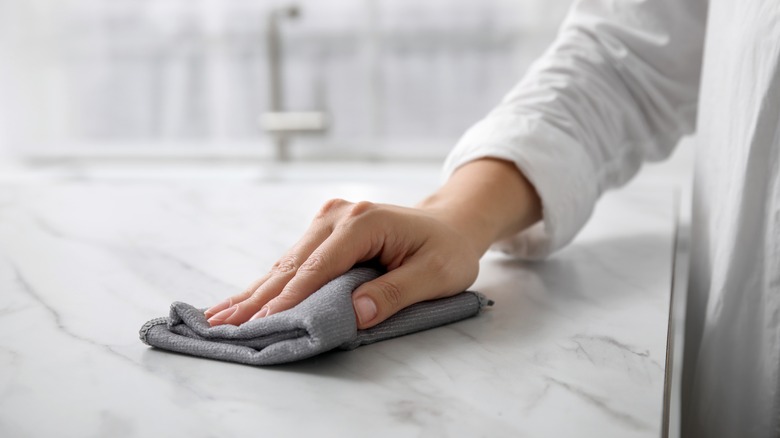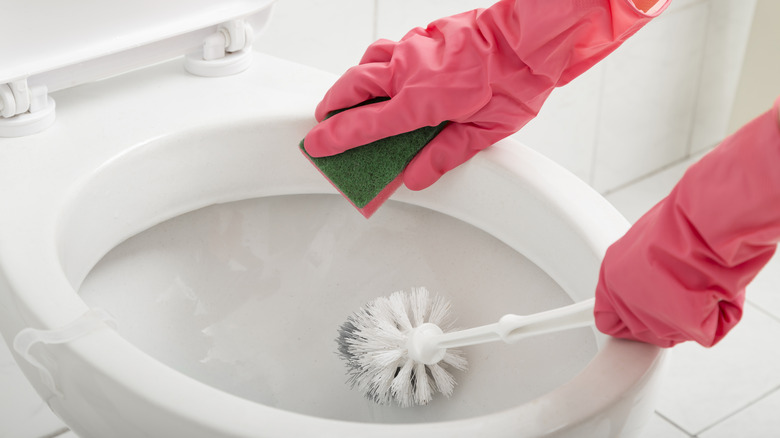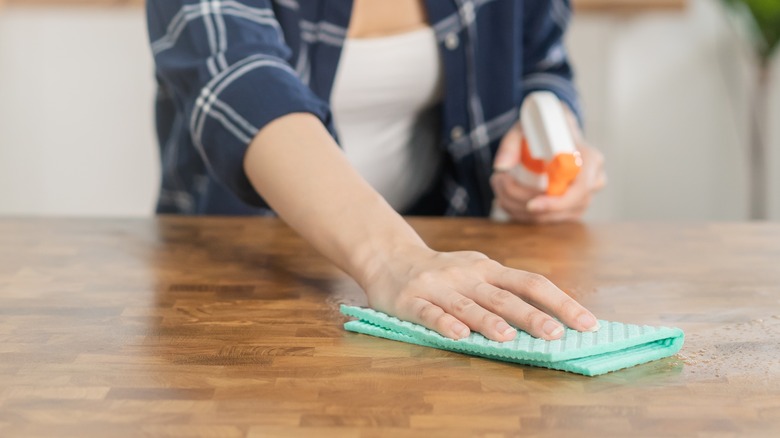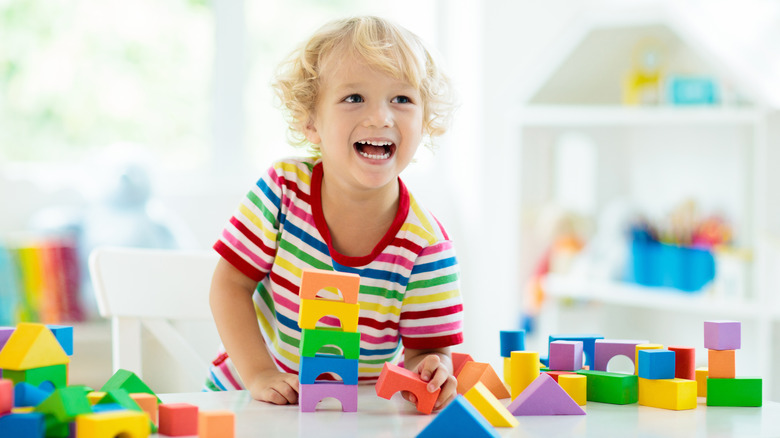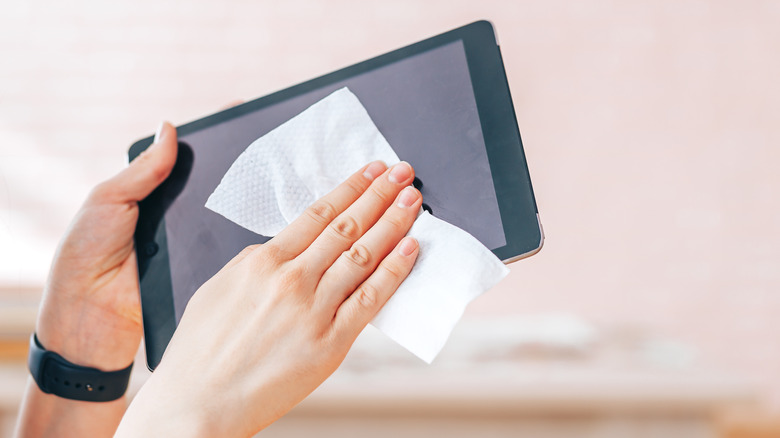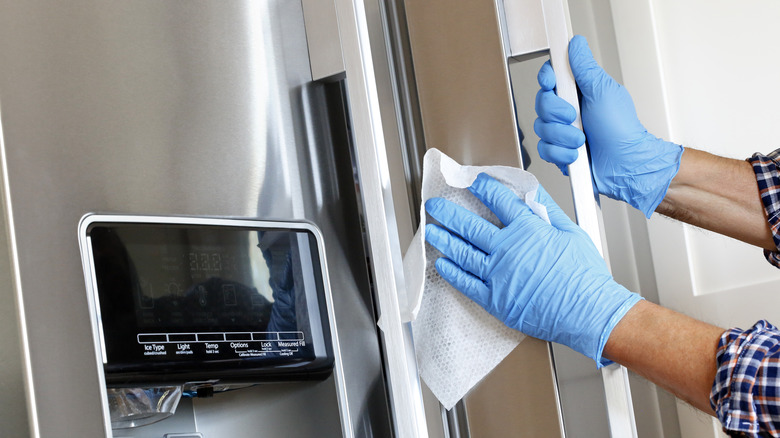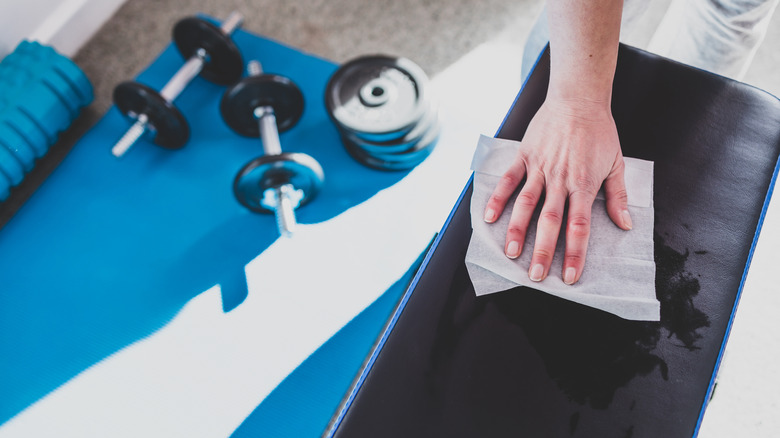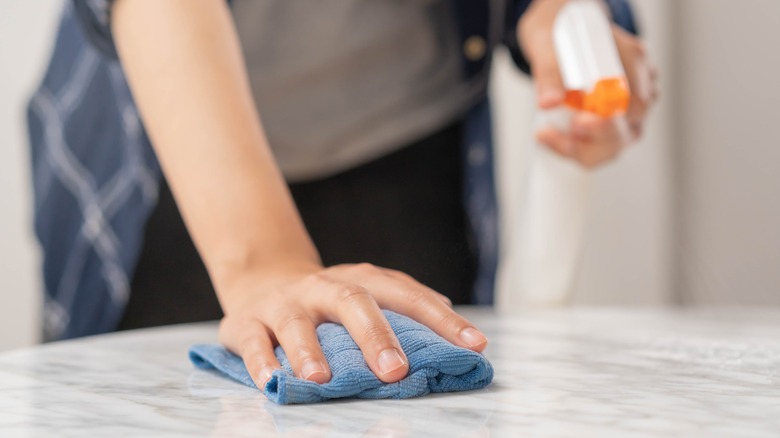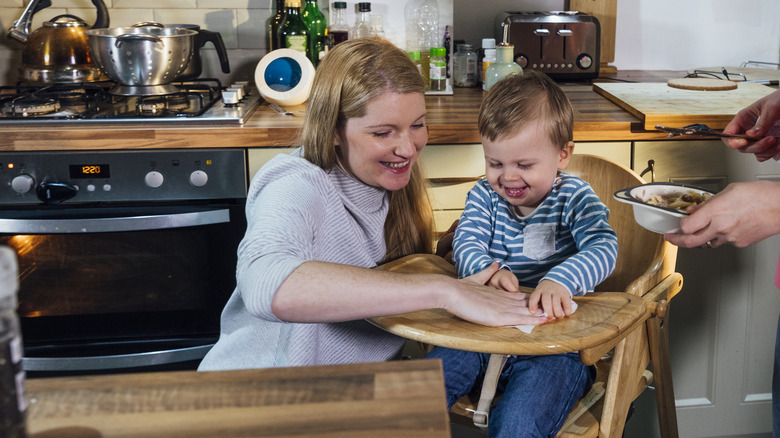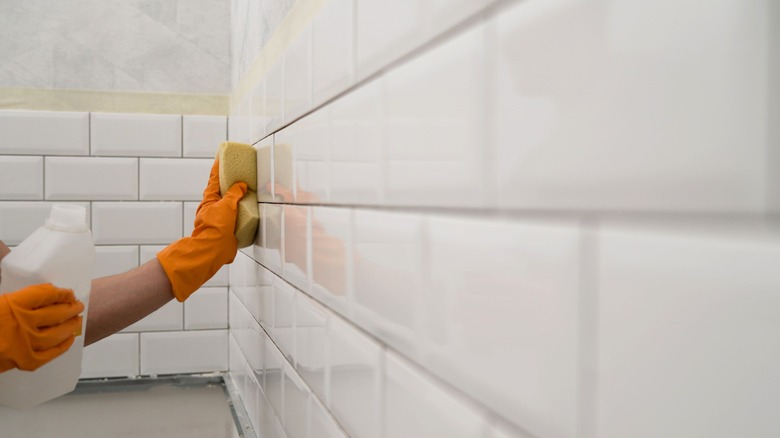You Should Never Use Bleach To Clean These 9 Things
As much as bleach is a wonderful product for cleaning and sanitizing, there are plenty of mistakes people make when using bleach every day. For example, those new to hand-washing dishes may not know that if you use a bleach bath to sanitize them, they must air dry, not towel dry, so that any remaining product will evaporate. Bleach can also create air vapor, which is dangerous when inhaled and irritates skin and eyes alike, making it a bit of a double-edged sword when it comes to safe cleaning.
If messing up cleaning bleach-safe items is possible, it stands to reason that you may be misusing it in other areas — such as items that should never be bleached at all. There are some obvious ones that most people wouldn't miss, such as food, but other items may not be as obvious when needing an alternate cleaning product. Here are items you should never bleach, ensuring you keep you and your home safe.
Toilets with in-bowl cleaners
Usually, using bleach on your toilet bowl is no problem. In fact, this is an area that could probably use a good bleach-cleaning, considering all the nasty germs and bacteria that the toilet bowl can be a breeding ground for. However, if you have an in-bowl toilet cleaner or a cleaner that sits in the tank, you should be extremely cautious when doing your deep clean.
Mixing bleach with other chemicals is often a deadly recipe for disaster. Many toilet cleaning gels, for example, contain acid, and the acid-bleach combo creates toxic chlorine gas. You should never mix bleach with any other cleaner, but it's especially dangerous in the case of toilet bowl cleaners. Even if they do not have acid, you may have one that contains ammonia, which, combined with bleach, creates chloramines, according to TURI. Instead, it's best to skip the bleach in this case and use your regular toilet bowl cleaner for scrubbing.
Any kind of wood
You shouldn't bleach your wood floors and decks, countertops and tables, cutting boards, or any other wood accessories if you can avoid it. This is because bleach can shift the wood's pH, damaging its cells. This means it damages the material, weakening its composition and maybe even changing its color. Instead, you might want to use a wood-specific cleaner, such as PineSol, for wood floors. However, counters and other wood surfaces can be a little more tricky, especially when you want to sanitize them after cooking or eating; doubly in the case of having prepared raw meat or other bacteria-inviting ingredients.
There are a handful of ways to clean your solid wood countertops, but to start with, you should be conditioning them with wax or oil to prevent damage during use and cleaning alike. Cleaning a conditioned wood surface is easier, and often times you should be fine to just use soap and water. For sanitation, instead of bleach, try food-safe concentrations of hydrogen peroxide, which can be diluted with water and applied on a cloth or used as a spray. Don't use abrasive materials to clean your wood, as you could scratch the finish or leave fine lines on the surface, which not only ruins the look but also gives germs and bacteria just another place to hide and grow.
Children or pets' toys
If a toy may end up in a mouth — either your child's or a fur baby's — then the safe option is to stay away from bleach. Bleach is toxic if ingested, and while there are safe dilutions, it's something that can easily be done wrong. Skip bleach altogether with children and pet toys. While different playthings will call for different cleaning solutions, they all have bleach alternatives.
Soap and water are a great first step in regular cleaning to stop the spread of germs. Spraying toys with a one-part-vinegar-two-part-water solution is also a great natural disinfectant that can be safely ingested, according to Modern Castle. Cloth or fabric toys can almost always go in the washing machine. Above all, though, be sure that in your regular cleaning of certain toy types, you do not use anything that could be toxic. For example, you may have a regular wood cleaning solution, but you should be absolutely certain it is non-toxic before using it on children's wood building blocks. Always ensure toys are dry before returning them to play areas, and check that no spray residue is left behind.
Any electronic devises
Phones may be our number one electronic, but there are plenty of other devices we can't seem to live without. Tablets, computers, gaming systems, security devices, and so many other gadgets make modern life what it is. And with so many devices, cleaning them can fall to the back of your mind. However, electronics are just as likely to have bacteria growing on them as anything else. More likely, in fact, in the case of your phone, which is one of the dirtiest objects you come into contact with throughout your day, according to StateFoodSafety. So why not use bleach? Every device is different, but many plastics can be damaged by harsh chemicals, and smart devices often have an oleophobic coating that bleach can degrade and ruin.
So, how do you clean these devices without ruining them? Step one is to power them down to minimize the chances of shorting anything out due to liquid exposure. Then, you can use an alcohol solution cleaner to wipe down your devices. You should use a microfiber or non-abrasive cloth and put the liquid solution on the fabric instead of directly on the device. Be gentle and avoid ports, which should be kept dry and cleaned separately.
Stainless steel in any form
While it may directly clash with the name, stainless steel isn't, well, stainless. So it may shock some that trying to remove stains from stainless steel can actually make them worse, especially if you are using bleach or chlorine. Both chemicals can heavily damage the material, leaving your high-end appliances looking dingy and old. So, how do you keep your appliances clean?
Stainless steel cleaners are a great place to start, but for the simple DIYer, other options exist for sanitizing the fingerprint-coated fridge handles. The Maids has a great recipe that will leave your stainless steel looking brand new, and more importantly, clean. This solution calls for dish soap, baby oil, water, and three cloths — preferably microfiber, but any non-abrasive should do. Mix 1 teaspoon of dish soap into 1 quart of warm water, then use a clean cloth to wipe with the grain. Do this twice, both times with new solutions and fabrics, and once the appliance is dry, finish the task off with the last cloth dampened with a bit of baby oil to give it a shine.
Public or private gym equipment
Regardless of whether or not your gym is private or public, you'll want to clean it off before and after use, both to be polite for the future user and to take good care of the equipment. If you don't, it can easily spread germs or show leftover sweat. However, you may be surprised to find that many common disinfectants can destroy gym equipment. According to 2XL Clean Insights, ammonia, alcohol, hydrogen peroxide, and bleach should all be avoided when cleaning it down. There are many materials used in these items that will break down, corrode, or discolor when exposed to bleach, and some gym items shouldn't have liquid cleaners applied to them at all. Obviously, leaving them as is won't work, but with bleach and many other liquids out of the picture, it may be difficult to see an alternative.
So what to use instead? QUAT-based and phenol-free cleaners are best — specifically, wipes. Wipes are best to use on equipment since an overuse of spray can cause liquid damage. With wipes, there's no guesswork on how much solution to apply to a surface. If you do use a solution to clean your gym equipment, spray it onto your cloth and not the equipment itself, and be sure to use microfiber or non-abrasive cloths when doing so.
Porous counters or tiles
If you have porous surfaces in your home, such as concrete floors, you may know that they tend to absorb every liquid that gets on them and that those liquids can stain. Porous countertops — such as marble and granite — treated with bleach may have their color changed or, worse, bleach may cause etching, dulling, and pitting. Porous tile can also mold. At first, bleach might seem like the perfect way to kill it, but in actuality, it can promote deeper growth. Mold Masters writes that bleach only kills surface mold and allows deep-set mold to keep growing due to the added moisture, all while losing its effectiveness over time.
The best method for cleaning porous countertops isn't bleach, and it's not an acid or vinegar. Your first stop with marble should be soap and water on a cloth; never resting water. For disinfecting, there's a bit more to it. Arch City recommends rubbing alcohol or isopropyl, which will not stain, etch, or otherwise harm marble countertops. Four tablespoons of rubbing alcohol, 8 ounces of water, plus a drop of dish-cleaning liquid make for the perfect marble disinfectant spray. Remember to always dry your porous tiles after cleaning them; don't allow liquids to sit!
Any children's furniture
Similar to bleaching toys comes the risks of bleaching children's furniture. The New Jersey Department of Health links cleaning children's objects with bleach to breathing issues and irritation to the skin and eyes, all three of which are more worrisome in children. Many children's items are also made of materials that bleach can break down, such as wood, soft plastics, cloth, and fabrics.
Disinfecting and sanitizing are important in kids' playrooms, though, so what do you use instead? While soap and water go a long way and should always be your first step, there are safer alternatives for disinfecting and cleaning the germ-heavy places in your children's rooms, too. NJ Health recommends hydrogen peroxide as the next best thing, as it rapidly breaks down when it contacts water and oxygen and does not leave any residue behind. Most importantly, though, it does not produce vapor like cleaning with bleach does, so it won't cause any breathing problems on its own. Just make sure to properly dilute it following its label before using it as a cleaning agent. In addition, ensure that children's items are completely dry and have no residue before returning any objects to areas where they are accessible to kids, even when working with hydrogen peroxide.
Tile grout
Grout in tiles, most often found in your bathroom, might look a little nasty after some time, especially if it starts growing mold and mildew. However, as with porous tiles that may begin to collect mold, bleach isn't the best answer to the problem, even if it is the first mold-killing agent that comes to mind. While bleach might seem like a good fix at first since the grout will appear whiter for a time, it won't get to the deeper layers of your grout, where the roots of the mold lie.
Instead of bleach, try the easy-to-get, non-toxic, and edible alternative: white vinegar. It can be hard to believe that such innocuous options can truly stand up against tough molds and bacteria, but it's true. White vinegar kills most mold while digging deep beneath the grout's surface to get to the hard-to-reach layers of base growth. You don't even have to dilute it, though you can to make your supplies last longer. Pour or spray, then scrub away, and your grout should be clean in no time. Vinegar also works great on tile, so feel free to keep a spray bottle of white vinegar and water on hand for easy shower cleaning.
